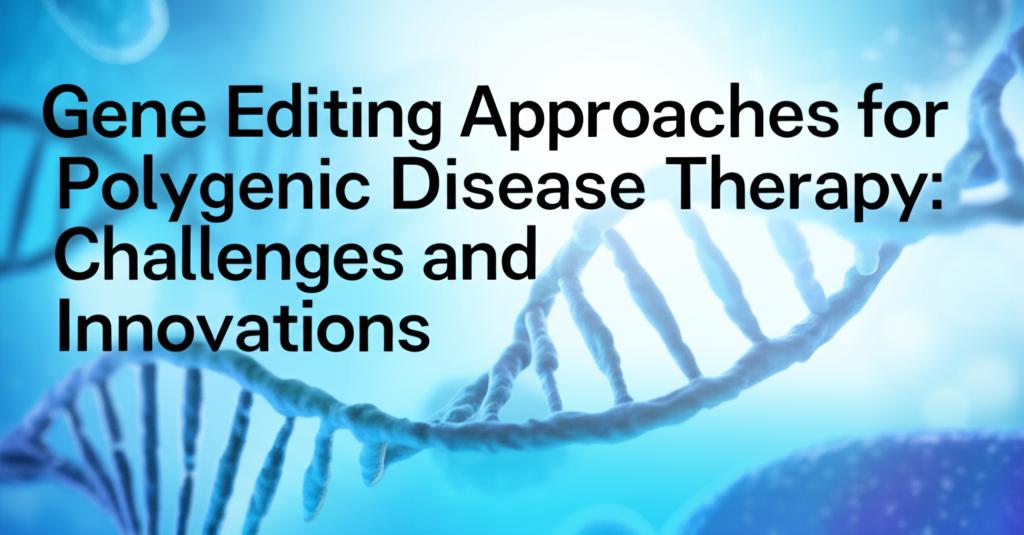Polygenic diseases, which result from the combined effects of multiple genes and environmental factors, present significant hurdles for gene editing therapies. Unlike monogenic diseases caused by a single gene mutation, the complexity of polygenic conditions makes identifying and targeting all contributing genetic factors a daunting task.
Challenges in Gene Editing for Polygenic Diseases:
- Complexity of Genetic Interactions: Polygenic diseases involve numerous genetic variants, each with a small effect, spread across the genome. Understanding the intricate interplay between these genes and their collective impact on disease development is a major challenge.
- Identifying Therapeutic Targets: Pinpointing the most critical genes or genetic pathways to target for therapeutic intervention is difficult. The sheer number of involved genes means that correcting a single or even a few genes may not be sufficient to reverse or significantly alleviate the disease.
- Off-Target Effects: Gene editing tools, such as CRISPR-Cas9, can sometimes make unintended cuts at sites in the genome that are similar to the target sequence. While precision has improved, the risk of off-target mutations, which could have unknown and potentially harmful consequences, remains a concern, especially when multiple edits are required.
- Delivery Mechanisms: Effectively delivering gene editing machinery to the correct cells and tissues in the body is a persistent obstacle. Viral vectors are commonly used but can trigger immune responses or integrate at unintended genomic locations. Non-viral methods like lipid nanoparticles and electroporation are being explored but face challenges in efficiency and specificity.
- Efficiency of Editing Multiple Genes: Simultaneously or sequentially editing multiple genomic loci with high efficiency and precision is technically demanding. Ensuring that all intended edits are made correctly in the target cells without causing cellular stress or damage is crucial.
- Long-Term Efficacy and Safety: The long-term effects of gene edits for polygenic diseases are largely unknown. It's essential to monitor patients for extended periods to assess the durability of the therapeutic effect, the stability of the edited cells, and any potential late-onset adverse events.
- Ethical Considerations: Germline editing, which involves modifying genes in sperm, eggs, or embryos, raises significant ethical concerns as these changes would be heritable and could impact future generations. There are also concerns about equitable access to these advanced therapies.
- Environmental and Lifestyle Factors: Polygenic diseases are often influenced by environmental and lifestyle factors. Gene editing alone may not be a complete cure if these external contributors are not also addressed.
Innovations in Gene Editing for Polygenic Diseases:
Despite the challenges, researchers are actively developing innovative approaches to tackle polygenic diseases:
- Advanced CRISPR-Cas Systems: Newer CRISPR variants like base editors and prime editors offer greater precision by allowing single nucleotide changes without causing double-strand DNA breaks, potentially reducing off-target effects. Variants like Cas12 and Cas13 expand the range of editable sites and functions.
- Multiplex Gene Editing: Technologies are emerging that allow for simultaneous editing of multiple genes. For example, the "drive-and-process" (DAP) array uses transfer RNA (tRNA) to express multiple guide RNAs (gRNAs) from a single construct, enabling numerous edits with high precision.
- Improved Delivery Systems: Research into enhanced delivery systems, including novel viral vectors with better tissue specificity and lower immunogenicity (like adeno-associated viruses - AAVs), and sophisticated non-viral methods like engineered nanoparticles, is ongoing.
- Targeting Regulatory Elements: Instead of correcting numerous individual gene variants, some strategies focus on editing key regulatory elements that control the expression of multiple disease-associated genes.
- Focus on Cellular Survival and Pathways: For complex conditions like neurodegenerative diseases, therapies may aim to promote cell survival or modify broader biological pathways rather than correcting every single causative gene.
- Combining Gene Editing with Other Therapies: Integrating gene editing with other therapeutic modalities, such as cell therapy (e.g., CAR T-cell therapy for cancer), could offer synergistic effects.
- AI and Machine Learning: Artificial intelligence and machine learning are being leveraged to analyze vast genomic datasets, identify potential therapeutic targets, design optimal gene editing strategies, and predict off-target effects. This includes training protein language models to discover and optimize new CRISPR systems.
- Studying Disease Mechanisms: CRISPR tools are invaluable for creating cellular and animal models of polygenic diseases, allowing researchers to better understand their complex etiology and test potential therapies.
The journey towards effective gene editing therapies for polygenic diseases is complex and ongoing. While significant hurdles remain, continuous innovation in gene editing technologies, delivery methods, and our understanding of polygenic traits offers hope for future treatments for common and debilitating conditions such as heart disease, diabetes, neurodegenerative disorders, and certain cancers. The field is rapidly evolving, with many preclinical and clinical trials underway, bringing us closer to realizing the full therapeutic potential of gene editing.

